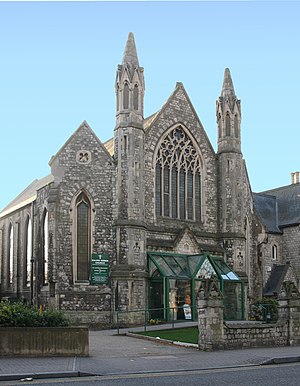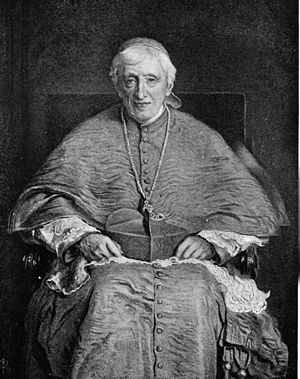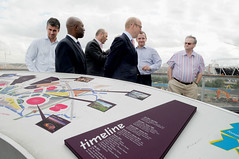 Image via Wikipedia Image via Wikipedia |
| Two intersecting circles illustrate Ken's point. |
The word “identity” has kept cropping up at ecumenical meetings and discussions recently. Thinking about it, it strikes me that there has been a shift over the years.
At one time we looked for areas where the circles of our various Churches’ identities overlapped, and we thought of that area as our common Christian identity or the identity of the universal Church of Christ that we share in common. We then sought to do everything that we could to expand that area of overlap, seeing the things in it as the essence of our identity as parts of Christ’s Church and the things outside it as secondary. It led to us talking of “the coming great church” and “visible organic unity”.
There are great strengths in that. But there are also some potential problems. One is that the giving and receiving of gifts (“receptive ecumenism”) could come to be seen as a matter of exchanging luxuries or ephemera rather than essentials (rather like Christmas presents for people who have got everything they think they want!). Another is that Churches (particularly but not exclusively large and powerful ones) can tend to assume that their secondary markers of identity will remain and that other Churches will just accommodate to them.
A third problem is that it works best with a conciliar view of ecumenism (in which ecumenical Councils of Churches are seen as prototypical governance bodies of a single united Church that is coming into being). So the shift towards a Churches Together way of working has been accompanied by a radical shift in the model.
The idea of separate Churches working together in a way that leads to visible communion (rather than merger into an homogenous, single institution) means that what defines each Church’s identity becomes not what it shares in common with others but the special attributes and emphases or particular combinations of them which distinguish it from others.
The danger then, however, is that things which seemed to be second-order or non-essential issues forty years ago now take on first-order importance (a phenomenon noted by the Archbishop of Canterbury in a speech in Rome last year). In this model the common essence of what it means to be Christ’s Church tends to vanish out of sight, or at best be subsumed into the things which differentiate that Church from others.
Moreover receptive ecumenism now becomes a giving and receiving of gifts that is akin to trading in essentials, with all the power-brokering that that entails. In other words it becomes even more difficult to do, particularly where the essentials are in tension with each other: for example (and admittedly to caricature the point in order to make it), “I will receive the gift of the historic episcopate from you provided that you receive from me the gift of the primary locus of oversight being the local congregation with which nobody else can interfere”.
I would like to think that there was another way forward. Identities are not suits of clothes that you can simply put on and take off. Even an actor who takes on the outward markers and even the intellectual and emotional mindset of a whole range of different characters has to find an integrity of performance, and that means recognising how the identity being assumed as an actor connects with the essential identity of the actor as a person.
Who we are as individuals and as Churches develops and changes over time. It gets expressed and re-expressed in different contexts. There are continuities and discontinuities in those forms of expression. But unless there is some underlying continuity in the development the result is dis-ease, a lack of wholeness and, dare I say it, a deficiency of holiness.
Thus my identity includes the fact that I am a son, to which I have added that of being a husband and being a father. But I would be a dysfunctional father if I forgot what it is to be a son. Similarly when St Paul says “To the Jews I became as a Jew… to the Greeks I became as a Greek… etc” in 1 Corinthians 9, he is not talking of a complete identity transplant. The one who becomes as a Jew and as a Greek remains the same Christian-Pharisaic-Jew or Jewish-Pharisaic-Christian. But that identity changes and develops as it is expressed in the different contexts.
To personalise it all, although I have not lived there for many years I am shaped by the fact that I come from a particular sort of setting in Lancashire. Similarly I shall always be shaped by the fact that I am a Methodist. But just as I can be a Lancastrian and live in other parts of the world, and be an ordained minister in the Church rather than a coal-miner, so I can be a Methodist within a wider expression of the Church. I admit that I am helped in that by the fact that Methodism’s origins (which set the parameters for its identity) were in being a movement inside another Church.
I therefore believe that a move into visible communion where what marks the Church of Christ is at least the highest common factor of our authentic identities as separate Churches (rather than the lowest common denominator of overlapping identity as in the first model above) and hopefully (in the theological sense of that term) more, and which can contain our differing identities in relationships which enrich us all, is possible.
So what is stopping us? At the recent joint meeting of the Methodist Council and the URC Mission Council people kept saying that there were things preventing them working together in worship and mission in local situations. When we asked them to say what they were, we had to keep saying “But you can already do that!”.
So is what is stopping us either a lack of confidence in our common identity as the Church of Christ, or our separate identities as Churches in Christ, or is it a lack of will?


































